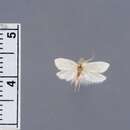Comprehensive Description
provided by Smithsonian Contributions to Zoology
Perzelia arda
Alar expanse 15–18 mm.
Labial palpus sordid white; second segment with light grayish suffusion anteriorly and on outer side; third segment grayish fuscous anteriorly. Antenna very pale grayish, annulated grayish fuscous; scape sordid white, infuscated dorsally. Head sordid white; face infuscated. Thorax sordid white. Forewing ground color sordid white; basally some pale ocherous suffusion; extreme edge of costa, at base, fuscous; underside of wing strongly overlaid fuscous; some specimens show a few widely scattered grayish-fuscous scales on upper surface of forewing; cilia white. Hind wing pale grayish, darker toward margins; cilia mixed sordid white and grayish. Foreleg sordid white; tibia and tarsal segments grayish fuscous on outer sides; midleg similar; hind leg sordid white. Abdomen sordid white heavily overlaid grayish fuscous dorsally; first segment of male with median eversible scale tuft.
Male genitalia slides USNM 24245, 24246. Harpe broad, tapering rather abruptly to the truncated cucullus; inside costa, near middle of harpe, a cluster of stout, truncated setae; before cucullus, on sacculus, a series of strong, short setae. Gnathos a spined, heart-shaped knob. Uncus large, hood shaped. Vinculum U-shaped. Tegumen subrectangular, slightly longer than uncus. Anellus a subrectangular, sclerotized plate with median posterior projection and a slender digitate process from base on each side. Aedeagus long, curved, pointed; vesica armed with one long, strong cornutus.
HOLOTYPE.—USNM 73695.
TYPE-LOCALITY.—Maule, Pelluhue, 600 m.
Described from the male holotype (2 Dec 1953, L. E. Peña) and 8 male paratypes, all with the same data.
Perzelia arda is similar to T. isaura, new species, but has a much darker hind wing.
Corita, new genus
TYPE-SPECIES.—Corita amphichroma, new species (by monotypy and present designation). The gender of this generic name is feminine.
Labial palpus recurved; second segment exceeding base of antenna, slightly roughened anteriorly; third segment slender, acute, shorter than second. Tongue well developed; maxillary palpus reduced, filiform, free. Head roughened with loosely appressed scales, side tufts spreading; ocellus absent. Antenna of male ciliated, female antenna serrate; scape without pecten. Thorax smooth. Forewing smooth, costa gently arched, apex slightly produced, termen below apex slightly concave, 12 veins, lb furcate; lc strongly preserved; 2 distant from 3; 3 from angle of cell; 3, 4, and 5 nearly equidistant, approximate; 7 and 8 stalked, both to costa; 9 much nearer to stalk of 7 and 8 than to 10; 10 nearer to 9 than to 11; 11 from well before middle of cell. Upper internal vein absent. Hind wing with 8 veins; 2 remote from 3; 3 and 4 stalked; 5 about equidistant from 4 and 6; 6 and 7 subparallel. Hind tibia roughened with long hairlike scales. Abdominal terga not setose.
Male genitalia with well-developed uncus and gnathos.
Female with signum present.
This genus appears to be very closely related to the New Zealand Gymnobathra Meyrick; in fact the only characters by which Corita differs from Gymnobathra are the absence of an ocellus and the stalking of veins 3 and 4 in the hind wing. In-as-much as Meyrick attributed an ocellus to many genera where there is none, we can discount that character and have left only the difference in the condition of veins 3 and 4 in the hind wing.
- bibliographic citation
- Clarke, J. F. Gates. 1978. "Neotropical Microlepidoptera, XXI : new genera and species of Oecophoridae from Chile." Smithsonian Contributions to Zoology. 1-80. https://doi.org/10.5479/si.00810282.273
Perzelia: Brief Summary
provided by wikipedia EN
Perzelia is a monotypic moth genus in the family Depressariidae. Its only species, Perzelia arda, is found in Chile. Both the genus and species were described by John Frederick Gates Clarke in 1978.
The wingspan is 15–18 mm. The forewings are sordid (dirty) white, basally with some pale ocherous suffusion and with the extreme edge of the costa, at the base, fuscous. The hindwings are pale grayish, darker toward the margins.
- license
- cc-by-sa-3.0
- copyright
- Wikipedia authors and editors

